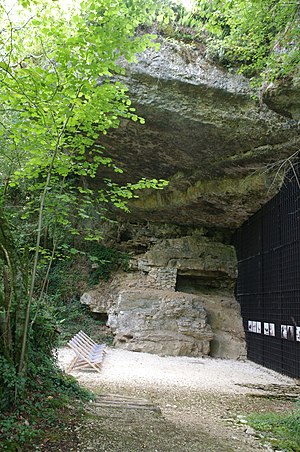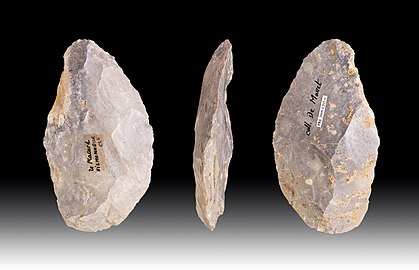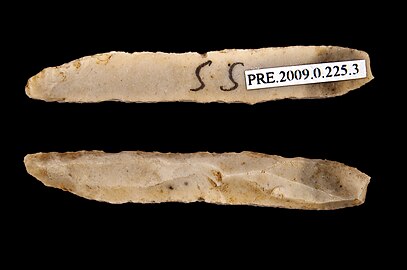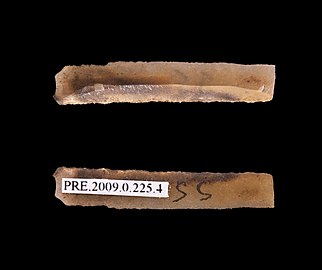Grotte du Placard
| Grotte du Placard
|
||
|---|---|---|
|
Grotte du Placard cave near Vilhonneur in Bajocium |
||
| Location: | Charente department , France | |
| Height : | 125 m | |
|
Geographic location: |
45 ° 41 ′ 23 " N , 0 ° 25 ′ 11" E | |
|
|
||
| Geology: | Jurassic Limestone | |
| Discovery: | 1853 | |
| Overall length: | 17 m | |
The Grotte du Placard is a cave in the former French commune of Vilhonneur in the Charente department ( Nouvelle-Aquitaine region ) - about 30 kilometers east of Angoulême - and contains petroglyphs from the upper Solutréen .
etymology
The French masculine noun placard has the meaning cabinet, closet .
geography
Together with the Grotte du Visage , the Grotte du Placard lies on the left side of the Tardoire valley . It is located 6.5 kilometers west-northwest of Montbron on a steep face near the hamlet of Rochebertier . Access to the cave is via the D 109.
description
The main cave is 17 meters long and 9 meters wide. Its entrance has a topographical height of 125 meters above sea level and opens into the middle Jurassic limestone of the Bajocium . A gallery branches off to the west with petroglyphs on the south side of the wall. The main cave ends in two narrow corridors in the northwest and in the north direction. The northwest corridor also has petroglyphs on both sides, the northern corridor is inert.
history
The Grotte du Placard was discovered around 1853. Excavations were carried out in the Arthur de Maret cave between 1877 and 1888. However, these caused great damage because, as was customary at the time, they only retained the objects classified as interesting. The cave was then examined several times. The 1902 excavations were funded by the French Association for the Advancement of Science ( Association française pour l'Avancement de Sciences ).
More than ten levels from the Middle and Upper Paleolithic have been found in the cave , in particular Magdalenian and Solutréen . The subdivisions of the Upper Paleolithic presented by Abbot Henri Breuil at the Geneva Congress in 1912 were based in part on the excavation results of the Grotte du Placard.
At the request of paleontologist Jean Piveteau , the excavations were resumed in 1958 by Abbot Jean Roche . Further investigations followed from 1987 by the archaeologist of the Charente department Louis Duport after a reindeer antler with incised drawings of cattle was found. It was Louis Duport who discovered the incised drawings on the cave wall in 1990 after he had exposed the side passage from the rubble. The research has since continued under the auspices of Jean Clottes and Louis Duport.
stratigraphy
The excavations from 1877 to 1902 established the following stratigraphic sequence in the Grotte du Placard (from hanging to lying ):
- an upper layer with historical remains that go back to the Bronze Age , but are very poorly documented
- a 1.5 meter thick level from the Magdalenian, which can be further subdivided into four layers
- a 1.0 meter thick level from the Solutréen
- a 1.5 meter thick level from the Moustérien .
In front of the cave in the open, Jean Roche found the following conditions:
- middle Magdalenian
- early Magdalenian
- toothed Moustérien (French Moustérien à denticulés )
- Moustérien.
In the gallery to the side, Jean Roche created the following stratigraphy:
- Magdalenian IV, mixed with younger elements for about 10 centimeters
- Location with small lime fragments
- Magdalenian IVa and IIIb with numerous drills, scrapers, blades and other artifacts - 20 centimeters thick
- middle Magdalenian with over 17 layers
- Cave floor made of parallel karst blocks.
Finds
In the midst of a very species-rich fauna , the remains of a saiga antelope ( Saiga tatarica ) were found in the Grotte du Placard, similar to other sites in the Charente .
Unfortunately, the lower jaw of a supposed Neanderthal child has now disappeared. A child's tooth discovered in 1960 was accompanied by artefacts from the Moustériens (Middle Paleolithic). Numerous bone finds of Homo sapiens have been made - including skulls that have been transformed into drinking cups. These finds come from the Solutréen (Upper Paleolithic).
Cave art
In 1990 a 5 meter long and 1.90 meter high frieze was discovered, which was hidden at the foot of the side wall of the gallery corridor under the waste of the layer assigned to the Solutréen. These are very fine, asymmetrically executed incised drawings. There are many horses shown, but also red deer, ibex, reindeer, a chamois, a saiga antelope, several cattle, an auroch and two bison sticking out their tongues.
A dozen or so bird-like bracket decorations are also present. These signs agree with the finds in Pech Merle and in the Grottes de Cougnac . The Cosquer Grotto near Marseille, 500 kilometers away, also contains very similar signs. Their dispersion over long distances during the solutre indicates a very important symbolic character of the signs.
When sifting through the rubble, 640 engraved limestone blocks came to light, which suggests that a large part of the side walls was covered with scratched drawings. As early as 1942, Raoul Daniel had been examining limestone slabs that had detached from the cave vault. One of them was covered with red ocher and carved with reindeer, another showed a deer.
Age dating with the C-14 method resulted in an age of 19,708 +/- 250 years ago for the scratch drawings, so they came from the Solutréen. Jean Clottes suggested that the petroglyphs encountered be assigned the term placard-type characters .
Tools and artifacts


The found stone tools of the Middle Paleolithic come from the Moustérien, more precisely from the Moustérien of the Quina type and the toothed Moustérien. The Solutréen (Upper Palaeolithic) is represented in particular by laurel and willow tips. The older Magdalenian provided scrapers and drills of various types.
In addition, numerous spearheads made from reindeer antler in Magdalenian were found, but objects made from other hard animal substances such as hooks, whistles, needles and pieces of jewelry (made of teeth and pierced shells) were also found. There were also spear throwers made from reindeer antlers with the hook typical of the middle Magdalenian. A 50 × 30 millimeter bone plate was recovered during the 1961-1962 excavation campaign. It must have been made from the shoulder blade of a large animal. The plate is serrated and carved on one side, probably depicting a fish.
Two objects made of reindeer antlers were in the shape of genitals and are interpreted as command baton. One of them is 140 millimeters long and shaped like a penis . The other measures 155 millimeters and ends in a pierced double cuff in which a vulva was engraved. A pierced rod made of reindeer antlers discovered by Arthur de Maret in 1870 carries an animal head as a sculpture - possibly a fox or an ibex is depicted.
meaning
The importance of the Grotte du Placard for Jean Clottes is based on the following points:
- Petroglyphs are generally very rare in Solutréen
- the incised drawings are unique in their ensemble for the Charente
- The quality of the drawings in combination with the enigmatic characters make the Grotte du Placard one of the main sources of Paleolithic art.
Protective measures
The cave became state property in 1990. Thanks to the measures taken by the Conseil général de la Charente, it is now open to the public during the summer months upon reservation. The Grotte du Placard was declared a Monument historique on March 3, 1989 .
Photo gallery
All the objects shown are in the MHNT in Toulouse.
See also
literature
- G. Le Pochat et al .: Montbron . In: Carte géologique de la France at 1/50 000 . BRGM, 1986.
Individual evidence
- ^ Jean Roche: Grotte du Placard . In: Bulletin de l'association française pour l'étude du Quaternaire . vol. 2, n ° 3-4, 1965, p. 250 .
- ^ H. Breuil: Les subdivisions du Paléolithique supérieur et leur signification . In: Congrès International d'Anthropologie et d'Archéologie préhistoriques, Compte rendu de la XIVème session . Geneva 1912, p. 5-78 .
- ↑ André Debénath: Les temps glaciaires dans le bassin de la Charente . CroitVif, 2006, ISBN 2-916104-00-3 .
- ^ Raoul Daniel: Pierres gravées de la grotte du Placard . In: Bulletin de la Société préhistorique française . t. 39, n ° 3-4, 1942, p. 117-119 .
- ↑ Jean Roche: Os incise provenant de la Grotte du Placard . In: Bulletin de la Société préhistorique française . t. 60, n ° 1-2, 1963, p. 75-78 .
- ^ A. de Mortillet: Deux curieuses pièces de la grotte du Placard . In: Bulletin de la Société préhistorique française . t. 3, n ° 10, 1906, p. 431-434 .
- ^ Catherine Schwab: Le bâton percé de la grotte du Placard . In: Archéologia . n ° 571, December 2018, 2018, p. 20-21 .










